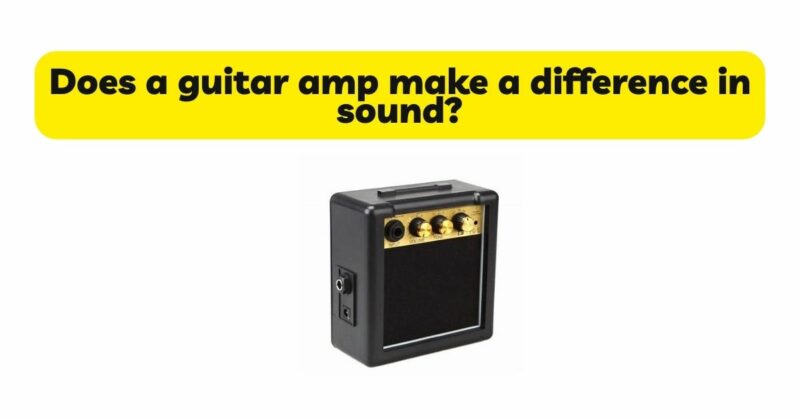For guitarists, the amplifier is not merely an accessory but a critical component that profoundly shapes their tone and playing experience. Choosing the right guitar amp can make a significant difference in sound, allowing musicians to achieve their desired tone and unleash their creative potential. In this article, we will explore the importance of a guitar amp in sound production, discussing the ways in which it influences tone, dynamics, and overall musical expression.
- Amplification and Signal Shaping: A guitar amp serves as both an amplification device and a signal shaper. It takes the electrical signal from the guitar pickups and amplifies it to a level suitable for driving a speaker. However, amps are not neutral in their amplification; they impart their own tonal characteristics, colorations, and sonic signatures to the signal. Different types of amps, such as tube amps, solid-state amps, or digital modeling amps, offer unique tonal qualities and colorations that significantly affect the sound produced.
- Tone and EQ Controls: One of the primary functions of a guitar amp is to provide tone shaping capabilities. Most guitar amps include built-in EQ controls, such as bass, middle, and treble, allowing guitarists to adjust the frequency response to achieve their desired tonal balance. These controls enable players to shape their sound by boosting or cutting specific frequencies, resulting in a tonal character that suits their musical style and preferences.
- Gain Stages and Overdrive: Guitar amps often incorporate gain stages that introduce varying levels of distortion and overdrive to the signal. The amount of gain applied affects the intensity of the distortion, allowing guitarists to achieve a range of tones, from clean and pristine to crunchy and saturated. Different amp designs and models offer unique overdrive characteristics, such as warm and smooth tube saturation or aggressive and gritty solid-state distortion, enabling musicians to explore a wide range of sonic possibilities.
- Dynamic Response: A guitar amp significantly influences the dynamic response of the instrument. The way an amp responds to a guitarist’s playing dynamics—how hard or soft they pick or strum the strings—greatly affects the expressiveness and musicality of the sound produced. Amps with good dynamic response can accurately reproduce the subtle nuances, attack, and decay of the guitar’s sound, allowing for greater control and expression in the music.
- Speaker Character and Cabinet Design: The speaker and cabinet configuration of a guitar amp play a vital role in shaping the overall sound. Different speaker types, sizes, and construction materials have distinct sonic characteristics, influencing factors such as frequency response, dispersion, and resonance. Additionally, the cabinet design affects how the sound resonates and interacts with the surrounding environment, contributing to the overall tone and presence of the guitar sound.
- Effects and Sound Enhancement: Many guitar amps include built-in effects such as reverb, delay, modulation, and more. These effects can significantly enhance the sound and expand creative possibilities for guitarists. The quality and versatility of the built-in effects vary among different amp models, providing players with options to experiment with different sonic textures and create unique sounds without the need for external pedals or processors.
- Interaction with Pedals and External Gear: A guitar amp’s design and characteristics greatly influence how it interacts with external effects pedals and other gear. The input impedance, signal chain, and overall tonal characteristics of the amp can affect the performance and sound of pedals, resulting in different levels of compatibility and tonal synergy. Guitarists often experiment with different amp-pedal combinations to find the best sonic combinations that suit their playing style and musical genre.
- Size and Portability: The size and portability of a guitar amp can also impact the sound experience. Smaller practice amps or compact modeling amps are convenient for home practice or small venues, providing a focused and controlled sound at lower volumes. Larger, higher-powered amps offer greater headroom and projection, making them suitable for larger stages and gigs where volume and sonic impact are crucial.
- Genre-Specific Characteristics: Different guitar amp models have become synonymous with specific music genres. For example, vintage tube amps are often associated with classic blues, rock, and jazz tones, while high-gain amplifiers are popular in heavy metal and hard rock genres. The tonal characteristics and sonic capabilities of different amps make them better suited for specific musical styles, allowing guitarists to achieve the signature sounds associated with their chosen genres.
- Personal Expression and Artistic Identity: Ultimately, a guitar amp contributes to a guitarist’s personal expression and artistic identity. The tone, dynamics, and sonic characteristics that an amp imparts shape a player’s unique sound and playing style. The choice of amp becomes an extension of the guitarist’s artistic vision, enabling them to convey their emotions, creativity, and musicality through their instrument.
Conclusion: Choosing the right guitar amp is a crucial decision that significantly impacts the sound, tone, and overall musical experience. A guitar amp serves not only as an amplification device but as a crucial component that shapes the sonic characteristics, tonal balance, and dynamic response of the instrument. By understanding the role of an amp in signal shaping, tonal control, dynamic response, and interaction with external gear, guitarists can make informed choices and find an amp that complements their playing style, musical genre, and artistic vision. With the right guitar amp, musicians can unleash their sonic potential, craft their unique tone, and embark on a journey of expressive musical exploration.


